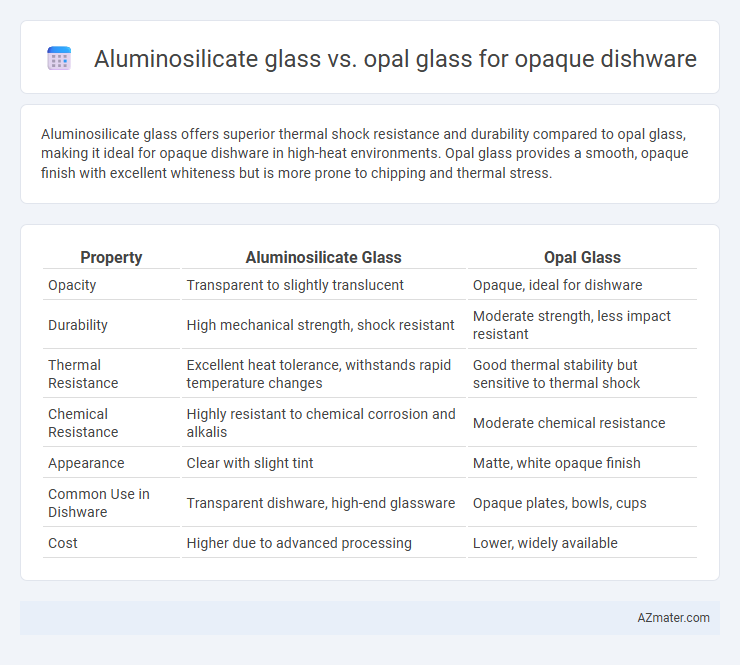Aluminosilicate glass offers superior thermal shock resistance and durability compared to opal glass, making it ideal for opaque dishware in high-heat environments. Opal glass provides a smooth, opaque finish with excellent whiteness but is more prone to chipping and thermal stress.
Table of Comparison
| Property | Aluminosilicate Glass | Opal Glass |
|---|---|---|
| Opacity | Transparent to slightly translucent | Opaque, ideal for dishware |
| Durability | High mechanical strength, shock resistant | Moderate strength, less impact resistant |
| Thermal Resistance | Excellent heat tolerance, withstands rapid temperature changes | Good thermal stability but sensitive to thermal shock |
| Chemical Resistance | Highly resistant to chemical corrosion and alkalis | Moderate chemical resistance |
| Appearance | Clear with slight tint | Matte, white opaque finish |
| Common Use in Dishware | Transparent dishware, high-end glassware | Opaque plates, bowls, cups |
| Cost | Higher due to advanced processing | Lower, widely available |
Introduction to Opaque Dishware Materials
Opaque dishware materials typically include aluminosilicate glass and opal glass, each offering distinct properties suited for durable, non-transparent tableware. Aluminosilicate glass is known for its high thermal resistance and mechanical strength, making it ideal for environments requiring durability and heat stability. Opal glass, characterized by its milky, translucent appearance, provides an elegant aesthetic with moderate resistance to thermal shock and impact, commonly used in both everyday and decorative dishware.
What is Aluminosilicate Glass?
Aluminosilicate glass is a durable, heat-resistant material composed primarily of aluminum oxide and silicon dioxide, offering superior thermal shock resistance compared to standard glass. This type of glass is commonly used in opaque dishware for its enhanced strength, scratch resistance, and ability to withstand rapid temperature changes without cracking. Its composition makes it highly suitable for both commercial kitchens and everyday use, ensuring long-lasting performance in opaque glassware products.
What is Opal Glass?
Opal glass is a type of opaque glass characterized by its milky white appearance, achieved by adding zirconium or titanium compounds during production. Unlike aluminosilicate glass, known for its high thermal and mechanical strength, opal glass offers excellent light diffusion and a porcelain-like aesthetic ideal for opaque dishware. Its unique composition ensures durability and provides a classic look commonly used in premium kitchenware and tableware.
Manufacturing Process Comparison
Aluminosilicate glass is produced through a high-temperature melting process that incorporates aluminum oxide, enhancing its thermal shock resistance and mechanical strength, making it suitable for durable opaque dishware. Opal glass, formed by incorporating opacifiers like bone ash or fluorides during melting, achieves its characteristic milky translucency through controlled crystallization and nucleation during cooling. The manufacturing of Aluminosilicate glass demands precise temperature control to maintain its structural integrity, whereas Opal glass requires careful regulation of opacifier dispersion to ensure consistent opacity and aesthetic quality.
Strength and Durability
Aluminosilicate glass exhibits superior strength and impact resistance compared to Opal glass, making it highly durable for opaque dishware applications. Its enhanced thermal shock resistance reduces the risk of cracking during rapid temperature changes, ensuring longevity in everyday use. Opal glass, while aesthetically pleasing and resistant to staining, generally offers lower mechanical strength and is more prone to chipping under heavy use.
Thermal and Chemical Resistance
Aluminosilicate glass exhibits superior thermal shock resistance, tolerating rapid temperature changes up to 700degC without cracking, making it ideal for opaque dishware exposed to high heat. Its chemical resistance is notable against acids and alkaline substances, ensuring durability and maintaining integrity over time. Opal glass, while offering good chemical resistance, is more prone to thermal stress and may crack under sudden temperature fluctuations, limiting its use in high-temperature applications.
Aesthetic Appearance and Color Options
Aluminosilicate glass offers a sleek, modern aesthetic with high clarity and a smooth surface that enhances vibrant and consistent color options, ideal for opaque dishware designs. Opal glass provides a classic, milky white translucency that delivers a soft, elegant appearance with a limited palette, often found in traditional and vintage-inspired dishware. Both materials support durability, but aluminosilicate glass excels in offering diverse color customization and a contemporary finish compared to the more uniform, subtle tones of opal glass.
Safety and Food Contact Suitability
Aluminosilicate glass offers enhanced durability and thermal shock resistance, making it highly suitable and safe for opaque dishware exposed to varying temperatures. Opal glass, composed mainly of soda-lime glass with added opacifiers, provides excellent chemical resistance and non-toxicity, ensuring safe food contact and preventing leaching. Both materials meet FDA and EU regulations for food contact safety, but aluminosilicate's superior mechanical strength makes it preferable in environments demanding higher impact resistance.
Cost and Market Availability
Aluminosilicate glass offers higher durability and thermal resistance but comes at a significantly higher cost compared to opal glass, making it less accessible for mass-market opaque dishware. Opal glass provides an affordable alternative with widespread availability, favored by manufacturers aiming for cost-effective, aesthetically pleasing opaque dishes. Market trends reflect strong demand for opal glass in budget-conscious segments, while aluminosilicate glass is reserved for premium, long-lasting dishware collections.
Best Choice for Opaque Dishware: Aluminosilicate vs Opal Glass
Aluminosilicate glass offers superior durability and resistance to thermal shock compared to opal glass, making it the best choice for opaque dishware in high-use or temperature-varying environments. Opal glass provides aesthetic appeal with its smooth, milky finish but lacks the mechanical strength and impact resistance of aluminosilicate. For opaque dishware requiring longevity and minimal breakage, aluminosilicate glass is the optimal material due to its enhanced toughness and stability.

Infographic: Aluminosilicate glass vs Opal glass for Opaque dishware
 azmater.com
azmater.com